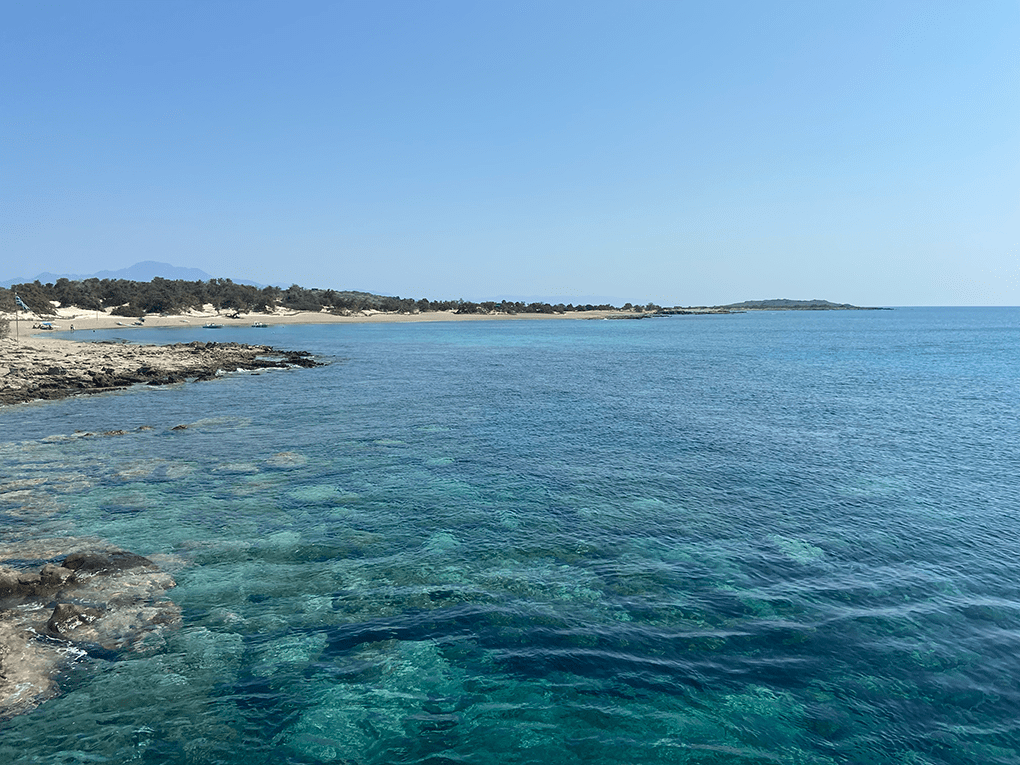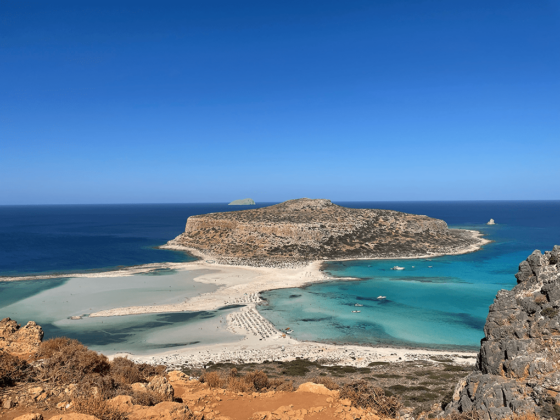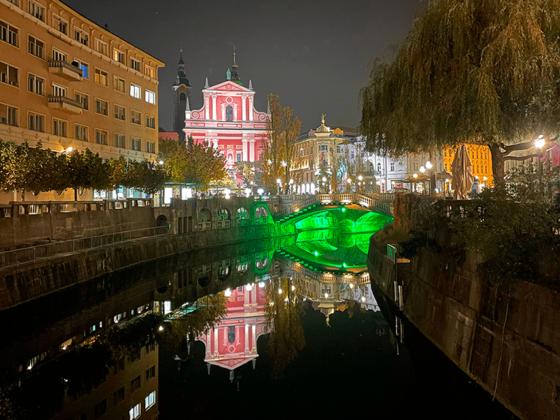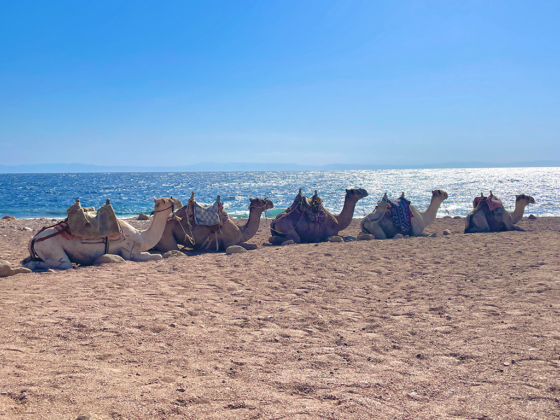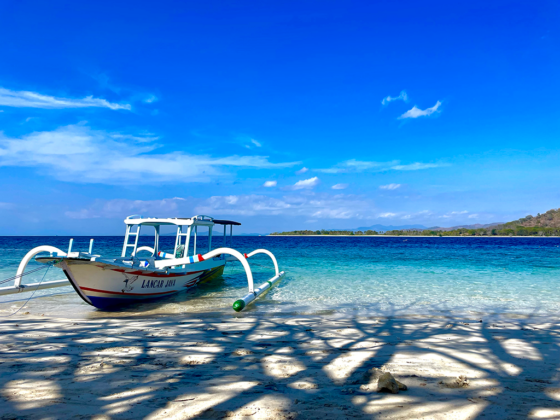During our 15-day tour of Crete, we travelled the length and breadth of the island. We loved everything about this magical island with its unspoilt nature full of picturesque villages, incredible archaeological sites but above all paradisiacal beaches that left us breathless. Wild and nestled between high rock walls or exotic and surrounded by palm trees, small bays or lagoons, Creata has more than 350 beaches, one more beautiful than the other.
In this article we tell you about our five favourite beaches in Crete.
1. Black Glyka

The bay of Glyka Nera is located in the south-west of the island of Crete and can be reached by boat from Hora Sfakion and Loutro, or by well-marked hiking trails. Its name in Greek means ‘fresh water’ due to the presence of fresh water bubbling up in small springs directly on the beach.
The cove is very picturesque. Surrounded by rock walls up to 500 metres high – part of the Lefkà Ori – that shelter it from the winds, and sprinkled with tamarisk trees that edge it, providing shelter from the sun during the hottest hours. The pebble beach is washed by the crystal clear sea with colours ranging from turquoise to emerald green to electric blue towards the open sea. On the beach is a bizarre tavern built on top of a rock in the middle of the sea, connected by a jetty to the sandy shore.
How to get to Glyka Nera
It is possible to reach the beach of Glyka Nera by sea or on foot.
Taxi boats leave from the port of Sfakia and take you directly to the beach in 10 minutes. These shuttle between Chora Sfakion, the beach and the beautiful, picturesque village of Loutro, which we definitely recommend visiting!
For those who enjoy trekking, there is a path of about an hour that crosses the cliffs. From Chora Sfakia going up towards Anapolis for a first stretch you follow the asphalt road until you reach a large hairpin bend where there is a sign indicating the path to Glika Nera. Here the path proper begins. Most of the path is on the edge of the cliff, which is very exposed so for those who suffer from vertigo it is best to opt for a boat.
Tips for trips: the walk is more than an hour and is certainly more difficult on the way back as it is uphill; moreover, the route is very exposed and without trees, so in addition to having comfortable clothing and shoes, the advice is to bring plenty of water to hydrate yourself as you will be perpetually under the scorching sun.
2. Seitan Limania
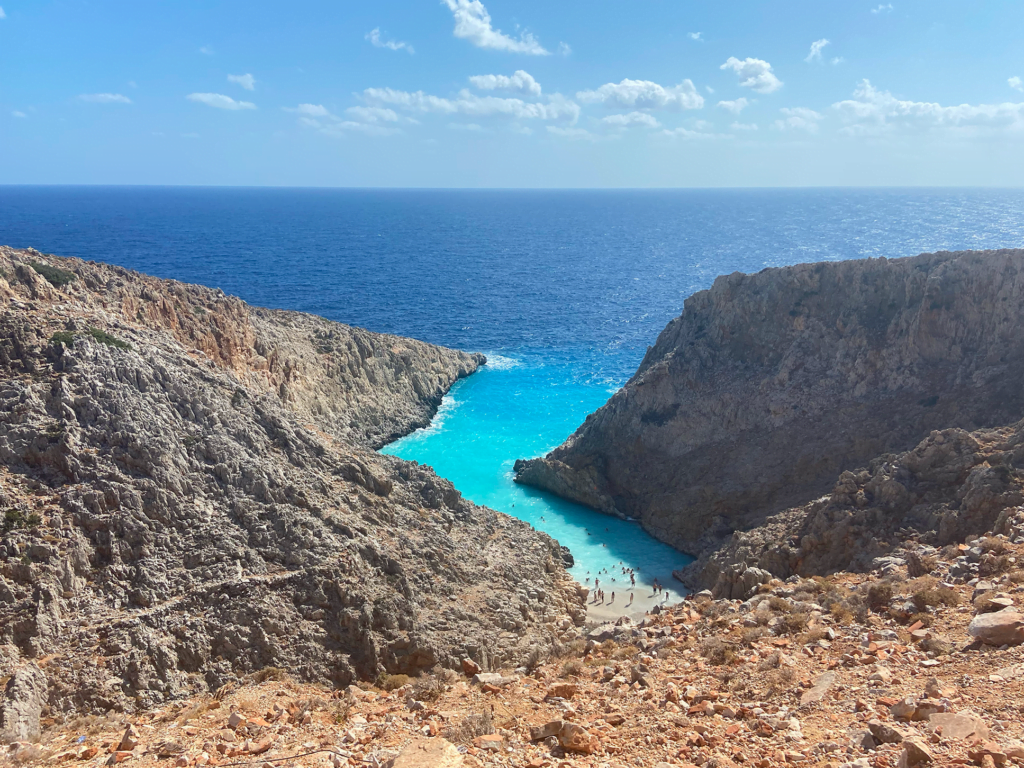
Seitan Limania beach is located on the Akrotiri peninsula, in the north-eastern part of the island. The meaning of Seitan Limania comes from two words: the first – Seitan – of Turkish origin meaning Devil, the second – Limania – Greek meaning Port. The beach can be reached by car as far as the car park; from there, one has to walk down the rock face that encloses the valley for about 20 minutes.
The beauty of this beach is its conformation. The incredibly turquoise water makes its way through a crack between the rocks creating a natural inlet that leaves one breathless. It is surrounded by an extremely wild landscape where the sea is often agitated by sea currents that shake its waters, creating a dazzling mixture of colours.
How to get to Seitan Limania
The beach can be reached by car in the direction of the Akrotiri Peninsula to the north-east by following the road to Rizoskloko. An asphalt road starts and descends steeply to nowhere until it reaches a sort of parking area. From there to get to the beach you have to ‘climb’ the rock face that encloses the valley, and it is recommended to have comfortable shoes because the path is steep and rather uneven. Just be a little careful and walk along it calmly, even Paolo managed it.
Tips for Trips: there are 2 paths to the beach. We chose the one on the right because although a bit longer it was apparently less steep.
3. Balos Lagoon
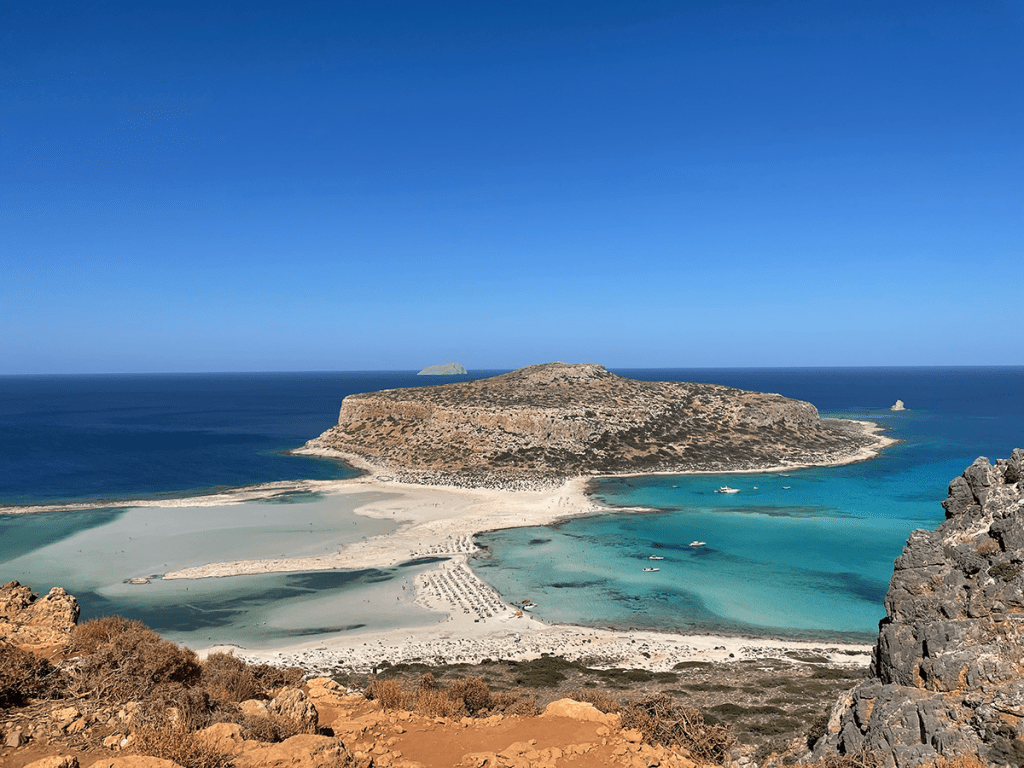
The Balos Lagoon is located on the very tip of the north-west coast of Crete between the island of Gramvousa and Cape Tigani. It can be reached by boat from Kissamos or on foot via a path and down a natural staircase for about 20 minutes.
The lagoon is formed by the silting up of the island of Cape Tigani, which, with two strips of sand/rock each about 400 metres long, divides the sea into small pools, creating the beautiful lagoon where the water is transparent and of many different shades. The beach is made up of dunes of very fine white sand consisting of shells and pulverised corals that sometimes have shades of pink. The Caribbean sea with its turquoise and pastel blue colours and surrounded by wild, unspoilt nature is always calm and warm with a very shallow seabed. Moving away from the coast, beyond the rocks, the water becomes deeper and colder and the seabed is perfect for snorkelling enthusiasts.
How to get to Balos
It is possible to reach the lagoon of Balos by sea or on foot.
Excursions depart daily from Kissamos and take an hour’s boat ride to the lagoon. The tour first stops at the island of Gramvousa and then at the beach of Balos, where you stop for about three hours before returning. Often the excursion is sold together with the bus from Chania or neighbouring villages, alternatively it is possible to reach the port of Kissamos independently. Personally I do not recommend this option, I have seen tourists disembarking from the ship late in the morning, in the thousands, invading a place of peace and beauty and spoiling the atmosphere… I did not have a good impression of the tour.
The second option is to arrive by your own car. The road to Balos is unpaved and exposed in some places, with many potholes of varying depth, but it is also very wide and can be travelled with any car. At the entrance to the dirt road you pay an entrance fee per person, and after less than 10 km you arrive at the car park. From here you then follow a path through a Mars-like landscape that immerses you. You then arrive at a natural staircase that leads to the beach in about 20 minutes.
Tips for trips: The route is very easy but it is not at all sheltered so it is best to arrive early in the morning to avoid the hottest hours – and the throngs of tourists arriving by boat – and bring plenty of water so as not to risk heatstroke.
4. Elafonissi
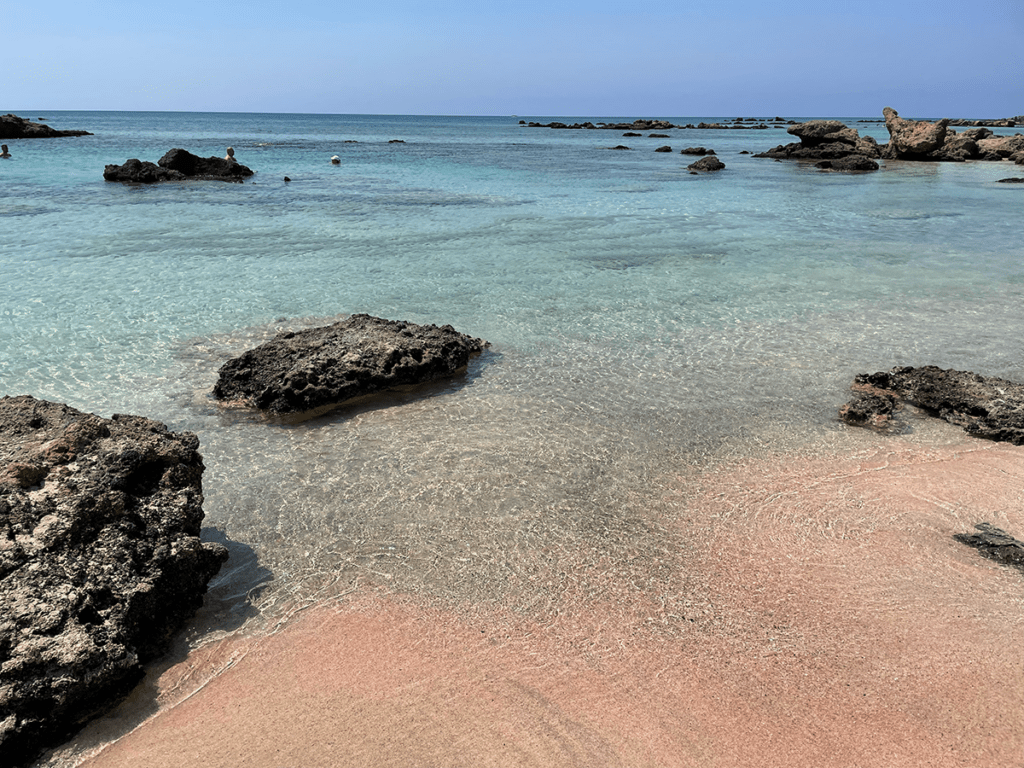
The beach of Elafonissi is located at the most south-westerly point of the coast. It is an elongated peninsula and, depending on the tide, seems to divide into two parts and rather than a stretch of sea, it looks like a natural pool.
The beach is of very fine white sand that turns coral pink in places due to the effect of crushed shells, all washed by a crystal-clear turquoise sea, clear and extremely calm. Directly in front of the beach is the small island of Elafonissi, which, at low tide, is connected by a narrow sandy strip, while at others it is a real island that can be reached by walking across the sea up to one’s knees. Following the sandy path one finds oneself in the southern part of the peninsula where there is less crowding and space to enjoy this paradise. At the far end of the island is a promontory where there is a lighthouse and the small chapel of Agia Irini, and when you reach the top you have a beautiful view of the entire coastline.
How to get to Elafonissi
The beach can be reached by car via two roads. The first, the longer one that runs along the entire western shoreline offers very beautiful views. The second, less scenic one, is an inland road that practically cuts the coastline.
5. Agiofarago
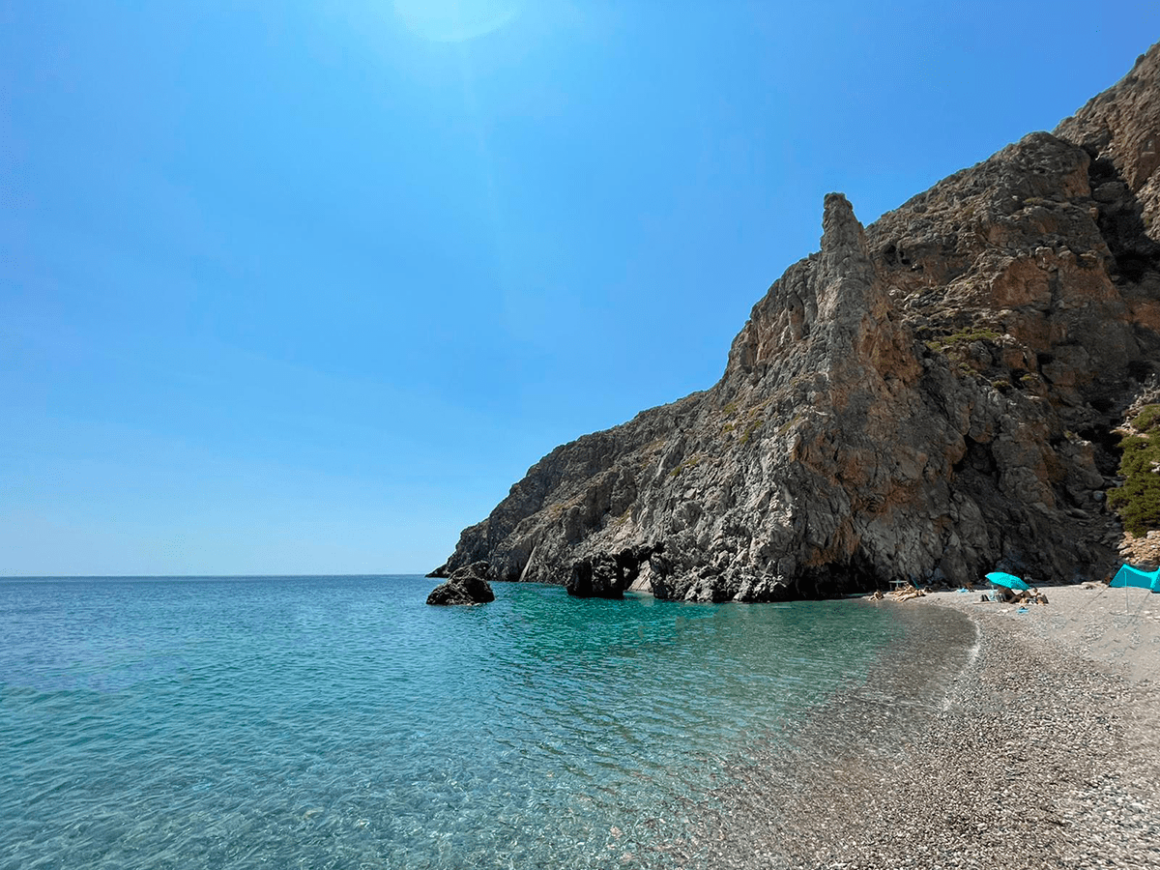
The beach of Agiofarago is located on the south coast of Crete, at the end of the Gorge of the Saints. It can be reached by car and then by a wild route of about 40 minutes or by boat from Matala, Kali Limene and Agia Galin.
he path along the gorge is itself part of the beauty of the beach. It is very easy, winding its way for 40 minutes through beautiful nature, but it is mostly in the sun. Along the way is the chapel of Agios Antonios with its bell – ringing it is said to bring good luck – and the well, the only source of water for hermits. Continuing towards the sea, on the left is the entrance to the cave of Goumenóspilios, consisting of a smaller cave at the entrance and a second larger one – 9 metres high and 7 metres wide – where St Antonios lived. Continuing on, one arrives at the beach, where the deep blue sea opens up like a mirage.
The pebble beach is surrounded by cliffs full of caves once used as sanctuaries or hermitages. The sea is deep blue and clear, always calm as the bay is sheltered from the winds. It is a wild and uncrowded place where one can spend time in a relaxed atmosphere while enjoying the view of the beautiful sea. In the western part of the cove, where the coastline ends in a sheer drop to the bottom of the sea, there is a small rocky arch over the sea under which to swim.
How to get to Agiofarago
The beach can be reached by sea or by car.
You can hire a boat from Matala, Kali Limene and Agia Galin to get to the beach. Even here, I have seen tourists arriving by taxi boat to the beach, littering the sea and breaking the quiet and atmosphere surrounding the place… I do not recommend it.
The second option is to arrive by car. Follow the road to Messara and continue past the village of Sivas until you reach the monastery of Odigitria. From here, turn left off the dirt road towards the port of Kaloi Limenes. After about 4 km you will find a signpost with directions to Agiofarago. To reach the beach, one must initially drive along a small, bumpy dirt road – but passable by all types of cars – to a large car park. There you will find a small kiosk that offers cold drinks and something to eat before venturing along the approximately 1 km path to the beach.
If you liked this article and want to know more about Crete, read our complete Crete, Mythological Island itinerary.
Last modified: 13 June 2025
